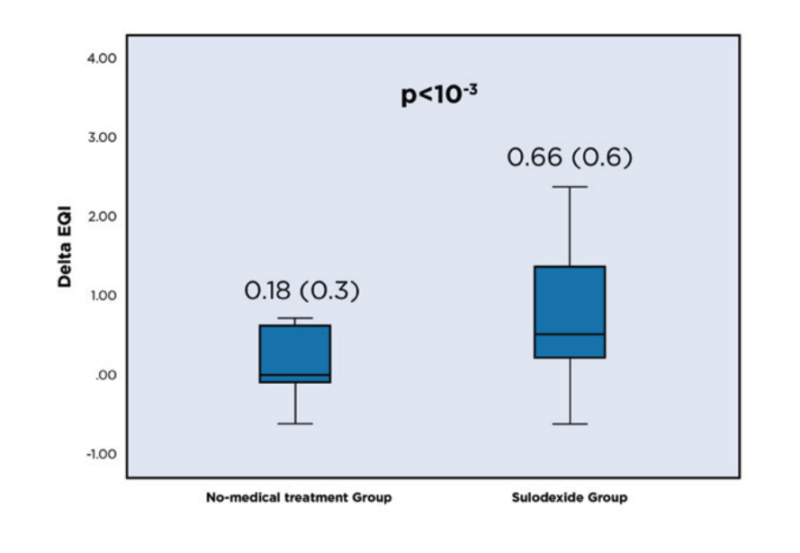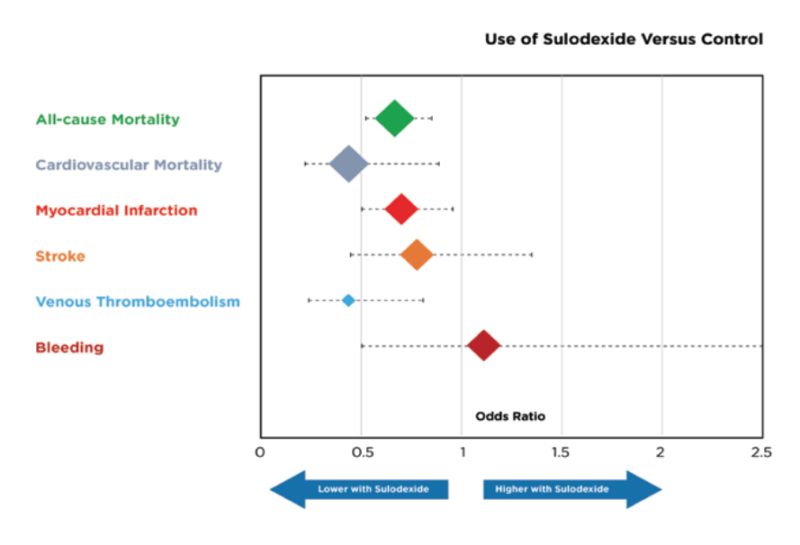Vascular diseases are deeply interconnected, as blood flow sustains every part of the body. For over 25 years, sulodexide has played a pivotal role in improving patient outcomes across this complex landscape. On February 7, 2025, the Corbridge Group convened leading experts from various specialties to explore the latest theories, practices, and breakthroughs in vascular disease management, with a particular focus on the multifaceted benefits of sulodexide.
SULODEXIDE AND VASCULAR AGING
Vascular aging, characterized by arterial stiffening, endothelial dysfunction, chronic inflammation, and impaired remodeling, is a key contributor to cardiovascular diseases such as hypertension and atherosclerosis.
1-3
Sulodexide, a combination of fast-moving heparin and dermatan sulfate, has demonstrated significant endothelial-protective properties. These include restoring the glycocalyx, enhancing nitric oxide-mediated vasodilation, and reducing vascular inflammation and oxidative stress.
4-5 Additionally, sulodexide has been shown to slow endothelial senescence, thereby maintaining vascular elasticity and function.
6-7
Dr Reyes highlighted clinical trials confirming these benefits, with one study reporting significant reductions in blood pressure (10.2/5.4 mmHg, P<0.001).
8
SULODEXIDE IN ARTERIAL AND VENOUS THROMBOSIS
Dr Reyes also emphasized a unified approach to arterial and venous thrombosis, as both conditions share endothelial dysfunction as a common pathway.
9 Sulodexide, a glycosaminoglycan with antithrombotic properties, exerts dual antiplatelet and anticoagulant effects.
10
The IPO-V2 study reported significant reductions in post-myocardial infarction cardiovascular events, including left ventricular thrombosis and mortality.
11 Furthermore, the TUN-EndCOV study highlighted improved endothelial function in long COVID-19 patients treated with sulodexide (Figure 1).
12 By protecting the endothelium and preventing both arterial and venous thrombotic events, sulodexide offers a comprehensive strategy for managing cardiovascular and thrombotic diseases.
 Figure 1. Sulodexide significantly improves endothelial dysfunction in patients with long COVID-19. Evolution of the endothelium quality index (delta EQI) at 21 days follow-up. Sulodexide group showed
improved delta EQI versus no-medical treatment group. (12)
Figure 1. Sulodexide significantly improves endothelial dysfunction in patients with long COVID-19. Evolution of the endothelium quality index (delta EQI) at 21 days follow-up. Sulodexide group showed
improved delta EQI versus no-medical treatment group. (12)
Peripheral vascular diseases, including chronic venous disease (CVD) and peripheral artery disease (PAD), are often overlooked despite their significant health burden. In the Philippines, five out of ten individuals suffer from chronic venous insufficiency (CVI), a severe form of CVD, while PAD increases the risk of cardiovascular death, myocardial infarction, and hospitalization due to atherothrombotic events.
13,14
Dr Arellano emphasized that CVD management, based on the CEAP classification, includes both conservative and interventional approaches. For C0 to C6 stages, conservative treatment, including pharmacotherapy, is preferred. Sulodexide has demonstrated significant benefits in CVD management, with clinical studies highlighting its venoactive properties. These include improved ulcer healing, alleviation of major symptoms (e.g., pain, heaviness, edema), and enhanced quality of life.
15-18 A 2024 study further supports its role in reducing proinflammatory markers and endothelial cell activation, potentially preventing CVD progression.
19
For venous thromboembolism (VTE), sulodexide’s anticoagulant properties have proven highly effective. The SURVET study showed a 50% reduction in recurrent VTE (HR 0.49, 95%CI 0.27–0.92).
20 A meta-analysis confirmed a 49% reduction in recurrent VTE (RR 0.51) and a 59% reduction in superficial vein thrombosis (RR 0.41).
21 Additionally, sulodexide reduced all-cause mortality by 33% (OR 0.67, 95% CI 0.52–0.85) and cardiovascular mortality by 56% (OR 0.44, 95% CI 0.22–0.89), with no significant increase in bleeding risk (Figure 2).
22 Dr Arellano also noted that various clinical guidelines include sulodexide as part of VTE management.
 Figure 2. Efficacy and safety outcomes with sulodexide versus
control. Size of the diamonds is proportional to the number of
patients in each analysis. (22)
Figure 2. Efficacy and safety outcomes with sulodexide versus
control. Size of the diamonds is proportional to the number of
patients in each analysis. (22)
PAD, one of the most underdiagnosed, underestimated, and undertreated forms of atherosclerotic cardiovascular disease, is a sign of widespread atherosclerosis. Dr Arellano stressed that PAD treatment has two key goals: preventing cardiovascular disease progression and improving patients’ quality of life by relieving intermittent claudication. Sulodexide has emerged as a promising adjunct therapy in PAD management. The SUAVIS trial demonstrated that sulodexide doubled pain-free walking distance in 23.8% of patients versus 9.2% in the placebo group, with a 65% increase from baseline.
23
A meta-analysis reported a 36% increase in pain-free walking distance and improved ankle-brachial index.
24 Furthermore, sulodexide demonstrated an 84-meter increase in pain-free walking distance (60% greater than comparators) and a 316-meter increase in maximal walking distance (2.4× vs. comparators).
25
MANAGEMENT OF GLYCOCALYX DYSFUNCTION IN DIABETES MELLITUES (DM) AND ITS COMPLICATIONS
In 2021, over 7 million people were affected by DM, with its macrovascular and microvascular complications remaining a significant burden. DM is the leading cause of diabetic retinopathy and nephropathy.
26 Dr Gomez highlighted how metabolic abnormalities in DM accelerate atherogenesis through a prothrombotic state, endothelial dysfunction, and vascular inflammation—all key targets of sulodexide.
27 However, she noted that many physicians still perceive sulodexide solely as an antithrombotic agent, overlooking its broader vascular benefits.
A six-year follow-up study found that impaired endothelial glycocalyx predicts adverse outcomes even in individuals without overt cardiovascular disease.
28 Thus, Dr Gomez emphasized the need for early intervention to prevent further endothelial dysfunction. Among the best practices in preventing cardiovascular complications in diabetic patients is the restoration of glycocalyx integrity, a role that sulodexide has been shown to fulfill.
27,29
Sulodexide has demonstrated efficacy in DM patients with peripheral artery disease and venous ulcers.
25 In reducing albuminuria for both types 1 and2 DM, a randomized controlled trial showed a statistically significant reduction versus the comparator.
30 Additionally, in non-proliferative diabetic retinopathy, sulodexide has been associated with decreased severity of hard exudates and a lower risk of retinal hemorrhages and intraretinal microvascularabnormality.
31
EXPERT INSIGHTS: PANEL DISCUSSION
 Panel of Experts: (from left) Dr Gilbert Vilela, Dr Rosella Arellano, Dr Honolina Gomez, Dr Raymond Rosales, Dr Ivan Villespin, Dr Lynn Gomez, Dr Jesus Tamesis Jr., and Dr Eugenio Reyes.
Panel of Experts: (from left) Dr Gilbert Vilela, Dr Rosella Arellano, Dr Honolina Gomez, Dr Raymond Rosales, Dr Ivan Villespin, Dr Lynn Gomez, Dr Jesus Tamesis Jr., and Dr Eugenio Reyes.
The meeting concluded with an enriching panel discussion moderated by Dr Gilbert Villela, featuring the speakers and other specialists, including Dr Raymond Rosales (neurologist), Dr Ivan Villespin (pulmonary vascular specialist), Dr Lynn Gomez (nephrologist), and Dr Jesus Tamesis Jr. (neuro-ophthalmologist).
Retinopathy: Dr Tamesis noted improvements in patients with ischemic extra-ocular palsies and cavernous sinus fistulas treated with sulodexide.
Nephrology: Dr Lynn Gomez emphasized its role in restoring the glomerular basement membrane matrix and improving endothelial function in diabetic patients with proteinuria or eGFR <40.
Neurology: Dr Rosales highlighted sulodexide’s potential in preserving the glycocalyx, which may explain its benefits in cerebral small vessel disease and blood-brain barrier (BBB) integrity specially in cases of COVID-19.
Pulmonary vascular disease: Dr Villespin reiterated its role as prophylaxis in high-risk cases, offering a safer alternative for thromboprophylaxis in high-bleeding-risk patients.
Diabetes and obesity: Dr Honolina Gomez noted that sulodexide may help prevent vascular complications in obese patients on GLP-1 receptor antagonists or those with contraindications to SGLT2 inhibitors.
SULODEXIDE AS A CORNERSTONE IN VASCULAR DISEASE
MANAGEMENT
From vascular aging and thrombosis to peripheral vascular diseases and diabetes-related complications, sulodexide’s endothelial-protective, anti-inflammatory, and antithrombotic properties make it a versatile therapeutic option. Its proven efficacy in improving outcomes—such as reducing blood pressure, enhancing walking distance in PAD, and restoring glycocalyx integrity in diabetes with a low bleeding risk—positions sulodexide as a cornerstone in vascular care.
The expert panel emphasized sulodexide’s role in bridging treatment gaps, particularly for high-risk patients with comorbidities or contraindications toother therapies. As research advances, sulodexide’s potential continues to grow, offering hope for better patient outcomes and a reduced global burden of vascular diseases.
References:
1. Mikael LR, et al.
Arq Bras Cardiol 2017;109(3):253–258.
2. Lakatta EG, Levy D.
Circulation 2003;107(1):139-146.
3. Ungvari Z, et al.
Circ Res 2018;123(7):849-867.
4. Raffetto JD, et al.
Biochem Pharmacol 2019 Aug;166:347–356.
5. Li T, Wang Y, et al.
Oncotarget 2017;8(53):91350–91361.
6. Suminska-Jasinska K, et.al.
Med Sci Monit 2011. Apr;17(4):CR222–6.
7. Urbanek T, et al.
Int Angiol 2016;35(2):140–147.
8. Olde Engberink RH, et al.
Br J Clin Pharmacol 2015;80(6):1245–53.
9. Vanhoutte PM, et al.
Acta Physiologica 2009;196(2):193–222.
10. Kustos SA, Fasinu PS.
Medicines (Basel) 2019;6(4):103.
11. CondorelliM, et al.
J Am Coll Cardiol 1994;23(1):27–34.
12. Charfeddine S,et al.
Front Cardiovasc Med 2022;9:866113.
13. Abola MB, et al.
Philipp J Cardiol 2015;43(1):1–6.
14. Abola MB, et al.
J Atheroscler Thromb 2020;27(8):809–907.
15. Pompilio G, et al.
Phlebology 2021;36(9):695–709.
16. Elleuch N, et al.
Adv Ther 2016;33(9):1536–1549.
17. ChupinAV, et al.
Adv Ther 2020;37(5):2071–2082.
18. Bignamini AA, Matuška J.
Adv Ther 2020;37(3):1013–1033.
19. Zieliński A, et al.
J Vasc Surg Venous Lymphat Disord 2024;12(5):101941.
20. Andreozzi GM, et al.
Circulation 2015;132(20):1891–1897.
21. Jiang QJ, et al.
Front Pharmacol 2018;9:876.
22. Bikdeli B, et al.
Semin Thromb Hemost 2020;46(8):908–918.
23. Coccheri S, et al.
Eur Heart J 2002;23(13):1057–1065.
24. Gaddi AV, et al.
JRSM Cardiovasc Dis 2020;9:2048004020907002.
25. Bignamini AA, et al.
Adv Ther 2021;38(3):1483–1513.
26. Cando LFT, et al.
Diabetes Metab Syndr 2024;18(2):102951.
27. Nieuwdorp M,et al.
Diabetes 2006;55(2):480–486.
28. Ikonomidis I, et al.
J Cardiovasc Transl Res 2022;15(4):890–902.
29. Broekhuizen LN, et al.
Diabetologia 2010;53(12):2646–2655.
30. Gambaro G, et al.
J Am Soc Nephrol 2002;13(6):1615–1625.
31. Song JH, et al.
Graefes Arch Clin Exp Ophthalmol 2015;253(6):829-837.

 Figure 1. Sulodexide significantly improves endothelial dysfunction in patients with long COVID-19. Evolution of the endothelium quality index (delta EQI) at 21 days follow-up. Sulodexide group showed
improved delta EQI versus no-medical treatment group. (12)
Figure 1. Sulodexide significantly improves endothelial dysfunction in patients with long COVID-19. Evolution of the endothelium quality index (delta EQI) at 21 days follow-up. Sulodexide group showed
improved delta EQI versus no-medical treatment group. (12) Figure 2. Efficacy and safety outcomes with sulodexide versus
control. Size of the diamonds is proportional to the number of
patients in each analysis. (22)
Figure 2. Efficacy and safety outcomes with sulodexide versus
control. Size of the diamonds is proportional to the number of
patients in each analysis. (22) Panel of Experts: (from left) Dr Gilbert Vilela, Dr Rosella Arellano, Dr Honolina Gomez, Dr Raymond Rosales, Dr Ivan Villespin, Dr Lynn Gomez, Dr Jesus Tamesis Jr., and Dr Eugenio Reyes.
Panel of Experts: (from left) Dr Gilbert Vilela, Dr Rosella Arellano, Dr Honolina Gomez, Dr Raymond Rosales, Dr Ivan Villespin, Dr Lynn Gomez, Dr Jesus Tamesis Jr., and Dr Eugenio Reyes.